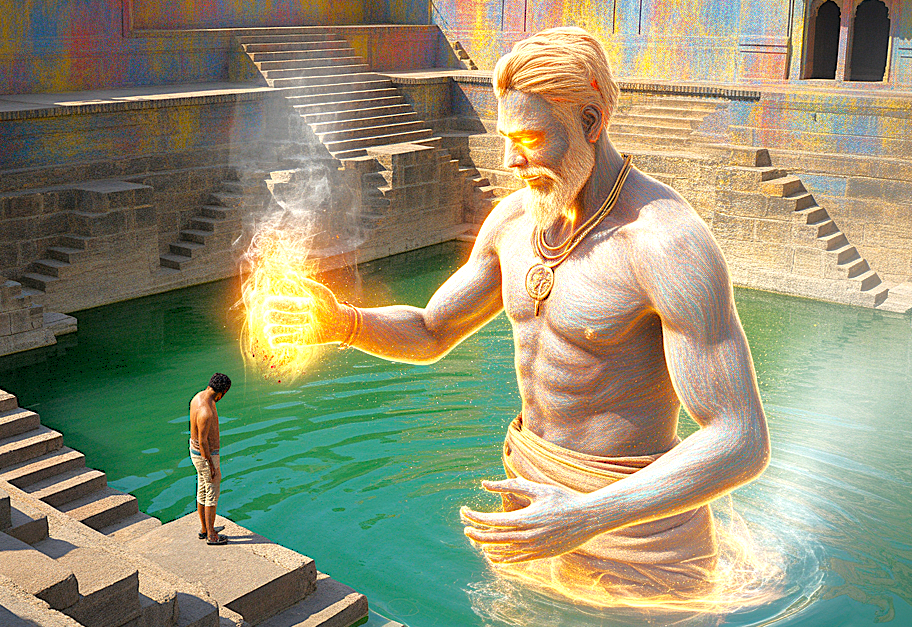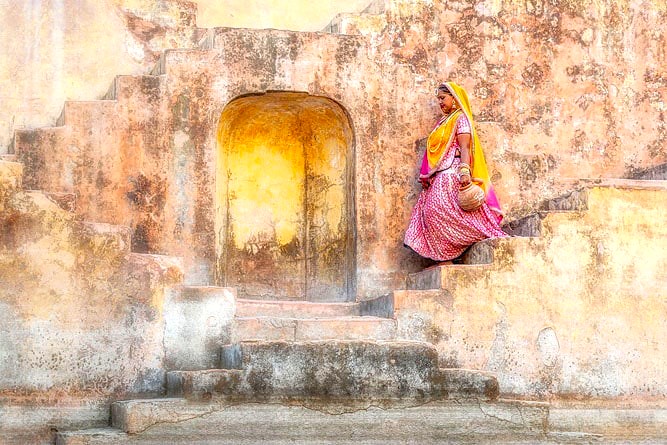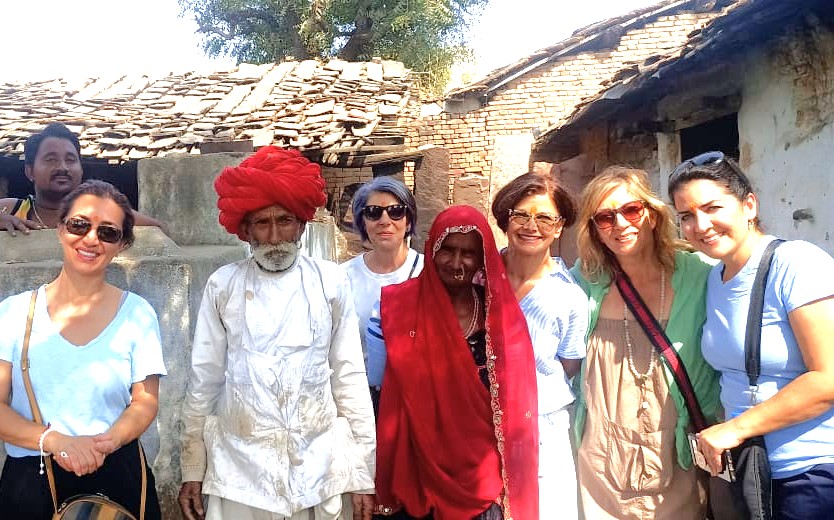Rajasthani Legends
Chand Baori Rajasthan India
Mother Masala Tours
The Depths of Ingenuity
Chand Baori Rajasthan India. Amongst the farmlands of India, the magnificent stepwell, a legacy of India's historical achievements. Located in Abhaneri, this impressive structure was built during the 9th century under the rule of the Chandela Dynasty, who are known for their contributions to Indian culture and society. The name "Chand Baori" is derived from the term "Baori," - stepwell. Legend suggests that "Chand" refers to a local ruler or deity associated with the region. Construction of the stepwell lbegan around AD 800, revealing advanced engineering techniques that allowed for precise geometrical construction and planning. At 20 meters deep, with an astonishing 3,500 steps leading to the water source. The population of Abheriri is 2,500, and the locals still engage in traditional farming practices on surrounding lands.

Chand Baori Rajasthan India: Timeless Artifacts
Serves not only as a water conservation system but also as a spiritual space for the local community. This Unesco World Heritage site exudes a peaceful atmosphere that invites reflection and contemplation. The deep well's structure is adorned with intricately carved motifs and statues that depict various deities and mythological figures. These carvings enhance the innate beauty of the site, complemented by the serene setting surrounded by ancient temples and flourishing greenery. The structure also features a beautifully designed courtyard and small shrines situated around the well, making it a gathering space for community rituals and celebrations.
Ancient Mosaics: Impeccable Craftsmanship

The artistry here is quite astonishing. Craftsmen of the time displayed profound skill and meticulous attention to detail, utilizing locally sourced sandstone for their creations. Their expertise transformed raw stone into lasting masterpieces that still capture attention. The stepwell incorporates exquisite carvings of floral motifs and mythological themes, revealing the artistry prevalent during the 9th century. Each precisely cut stone piece tells a story of dedication and precision, showcasing ancient tales and natural elegance. Featuring four tiers of steps, each adorned with these carvings, it combines beauty with clever design.
The Pulse of the Local Community
Chand Baori Rajasthan India. The residents of Abhanari remain deeply connected to their roots, forming a close-knit community centered around their heritage and traditions. Their hospitality is well-known, and the locals display a welcoming nature that enhances your experience while exploring the region. The sense of pride they have for landmarks like the Baori and their rich cultural history fosters an atmosphere of warmth and camaraderie. Have a chat while enjoying chai masala tea.
Capturing the Magic: A Photographic Haven

The Baori offers an incredible backdrop for photography, providing unique opportunities to capture striking images. The intricately designed steps, beautiful surroundings, and ornate carvings create many visual narratives that tell the story of this ancient site. With every angle revealing a new aspect of its beauty, photographers will find a treasure trove of compositions waiting to be explored. The play of light within the well adds a mesmerizing quality. Sunlight creates dramatic shadows, which highlight the architectural precision and historical depth of the structure.
Festivals of Devotion: Honouring the Sacred and the Divine
Abhaneri comes alive during various festivals, each highlighting the rich cultural tapestry woven by its community. One prominent festival is Maha Shivaratri, celebrated in February or March, when locals honor Shiva. This festival includes elaborate rituals and offerings, drawing people from neighboring areas to participate and pay homage at the prominent temples nearby. Another widely celebrated occasion is Teej, which occurs in July or August to welcome the monsoon season. Women and children engage in lively festivities, including dance, music, and adornment in colorful traditional clothing. This festival celebrates not only the arrival of rain but also the strength of femininity.
The Connection with the Gods

Chand Baori Rajasthan India. The spiritual significance in Abhaneri and surrounding temples deeply connects with local beliefs. The well itself is believed to possess mystical qualities, a source of ancient power. Locals often speak of spiritual guardians protecting the water at the deeper levels. These benevolent entities reveal themselves only to those descending alone at dawn or dusk from the water’s surface. This belief shapes local practices around the ancient stepwell, connecting daily life to spiritual tales. Stories are apart of the fabric, and we can observe these traditions woven into the village's identity.
Ancient Technologies: Sound, Sacred Geometry & Astrological Influences
Chand Baori Rajasthan India. The construction involves precise calculations that allowed for a beautifully symmetrical structure, substantial in spiritual practices. The 3,500 steps are arranged in a geometric formation that not only optimizes water accessibility but also creates unique sound frequencies within the well. The elements reflect a sophisticated understanding of natural resources, demonstrating a balance between function and spirituality. Additionally, the use of Solefeggio frequencies like 528 Hz - associated with transformation and miracles.
Serendipitous Meetings: Beyond the Main Path

Exploring the village of Abhaneri presents wonderful surprises as we venture beyond the main attractions. Small workshops line the streets, revealing the skills of local artisans who craft beautiful textiles, pottery, and intricate jewelry. These craftsmen often invite us to gaze at their processes, turning raw materials into art. The small enterprises and family-run businesses offer a glimpse into traditional practices that have withstood the test of time. Their ancient techniques continue to thrive here, sustained by generations of skilled hands. We see dedication in their work, revealing a living heritage in every corner.
Resilience and Renewal: Overcoming Adversity’s Challenges
Chand Baori Rajasthan India. Throughout history, inhabitants have faced significant challenges, prompting resilience among its community. In the 13th century, the village suffered from invasions associated with the Mughal conquests, resulting in a decline in population and cultural prominence. However, the tenacity of the residents allowed the community to rebound. Local leaders and families engaged in collaborative efforts to restore important sites, such as Chand Baori, during the 19th and 20th centuries.
Urban Legends: Strange Sightings, Myths and Mysteries

This architectural masterpiece near Uttar Pradesh is protected by Harshat Mata, the Goddess of joy and happiness. Local legends tell of her mystical appearances at dawn, when sunlight first touches the stepwell's intricate patterns. Some say she emerges in a golden glow, blessing visitors with prosperity and contentment. Her sacred presence is believed to purify the waters, making them healing for those who journey here. The symmetrical design mirrors her divine perfection. This ancient belief guides many daily traditions and cultural expressions. We observe this reverence deeply woven into the surrounding area.
India - Where The Best Mangoes Fall Right On Schedule
Chand Baori in Rajasthan India. We’re going, and you’re invited to experience the beauty and history of , and the local village of Abhaneri. Join us as we explore the depths of this ancient stepwell, uncovering its intriquing past and the stories that shaped its legacy. This journey is not just about exploring a place but about engaging with its heart and soul.
Symphony of Generosity: Offerings from Wanderers to Residents

Chand Baori Rajasthan India. The relationship between the locals of Abhaneri and those who explore its treasures creates a meaningful exchange that embodies community spirit. As we visit the village, our presence supports local artisans and businesses, fostering an economic lifeline that sustains tradition and craft. This interaction benefits both parties: while we gain insight into customs and heritage, the locals enjoy the opportunity to share their stories and skills, cultivating a deeper appreciation for their cultural identity.